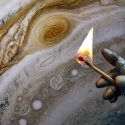What if Jupiter’s 79 moons weren’t gravitationally bound to Jupiter? What if they became rogue objects orbiting on their own paths around the Sun? Would they still be moons or something completely different? Could one or more collide with the Earth? And which moons could host extraterrestrial life?
Jupiter is the largest planet in our Solar System. It has a surface gravity two and a half times the Earth. And the planet’s enormous gravitational pull, combined with its great distance from the Sun, are two of the reasons why Jupiter has so many moons. These moons range in size from the smallest, S/2010 J 2, to the largest, Ganymede. It is larger than the planet Mercury.
Another of Jupiter’s moons, Europa, is about the size of our own Moon. And both Europa and Ganymede could have oceans of liquid water frozen beneath an icy surface. So if Europa and all the other moons abandoned their orbits, what would they become? How about hot, hellish rocks on a deadly collision course with the Earth?
While there is no exact definition of a moon, experts say it is an object that orbits a planet or dwarf planet. So the moment Jupiter’s moons leave their orbits, they would stop being moons and become something else. If the larger moons, like Ganymede, Callisto or Europa, gravitated toward the Sun, they could end up in the habitable zone of our Solar System.
This is the range within 0.9-1.2 AU of our Sun. That’s where the Earth is residing. Here, conditions are possible for liquid water to exist. And possibly life too. So if any of these moons settled into stable orbits within this so-called Goldilocks zone, you could catch the first glimpses of extraterrestrial life in our Solar System. Just give it a billion years.
But if these moons continued on their rogue orbital paths, they would likely end up being too cold or too hot to have conditions to support life. The ice that covers these moons would reflect sunlight into space. That means the rogue moons would have a high albedo. This would create a vicious cooling cycle as the sunlight would reflect instead of heating the icy surface of the moons.
That means instead of the ice melting, more ice would form, which would lead to more cooling and more ice. And so on. On the other hand, there could be an equally unstable warming cycle. Water vapor is a greenhouse gas that traps heat in the atmosphere. Just like carbon dioxide does on Earth. The hotter the planet, the more water would evaporate. That would lead to more water vapor and more heat. But more on that in a minute.
Jupiter’s former moons would require 10 to 40% more sunlight than the Earth not to become icy snowglobes wandering the Solar System. Plus, the help of other greenhouse gases like carbon dioxide. And maybe some volcanic eruptions. But too much help and that rapid warming effect could kick in, leaving the former moons hot and uninhabitable.
Then what? Well, now you’d better start to worry. These 79 rogue objects could end up on a collision course with us. At 2 km (1.2 mi) wide, the smallest moon, S/2010 J 2, would cause damage wherever it collided. But if any of the larger moons hit the Earth, you’d be doomed. Scientists say if an object with a width of 96 km (60 mi) collided with us, it would wipe out all life on Earth. And sorry to say, Jupiter has many moons that meet this deadly criterion.
Your only hope would be that our planet could potentially catch one or more of the moons in our gravitational pull. But that hope would be short-lived. Life on our planet would become difficult. Or impossible. Higher tides would render the coastal regions uninhabitable. You’d experience massive and more frequent tsunamis, earthquakes and volcanic eruptions.
These eruptions would spew out dust and toxic gases that would block out sunlight. On the bright side, you’d now have two or more beautiful moons in the night sky to admire.
Sources
- “Why Does Jupiter Have 79 Moons When Earth Just Has One?”. Mark Mancini. 2021. science.howstuffworks.com.
- “ESA Science & Technology – Jupiter’s Largest Moons”. 2019. sci.esa.int.
- “Ganymede: Facts About Jupiter’s Largest Moon”. Kim Zimmermann. 2016. space.com.
- “Jupiter’s Smallest Known Moon Unveiled”. 2012. space.com.
- “How Massive Must A Colliding Body Be To Disturb Earth’s Orbit?”. 2021. astronomy.com.



























